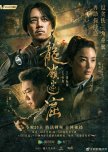As the rooster crows and the candle blows out...
...the grave robbers must cease all raiding activities and quickly leave the tomb. Such is the golden rule that all members of Mojin Xiaowei, one of the four major tomb raiding sects, must abide by.
Candle in the Tomb: The Lost Caverns is the direct sequel to Candle in the Tomb (2016), as far as the chronology of the Candle in the Tomb series’ web dramas are concerned. However, an entirely different cast has taken over from Jin Dong and Chen Chiao En, who headlined the first drama, and will continue with three more sequels in addition to this one, namely The Worm Valley (currently airing, at the time of writing), Raiders of the Wu Gorge and Kunlun Shrine. This, of course, excludes the timeline continuity of the numerous film adaptations, as well as prequel drama adaptations that have either already aired or presently in the pipeline as future projects.
Directed by Fai Zhen Xiang, who had helmed two earlier adaptations (The Weasel Grave and The Wrath of Time) and has directed The Worm Valley. He is certainly no stranger to the action adventure genre and his experience does shine through in his third foray into the series. Yang Zhe, who wrote the screenplay for Medical examiner Dr Qin, heads the screenwriting team comprising eight others. Principal photography took place amidst the vast rugged expanse of Shenmu county in Shaanxi province, bordering Inner Mongolia and situated across the Yellow River.
The plot is adapted from the second volume of Ghost Blows Out the Light (鬼吹灯) novel series written by Zhang Mu Ye. Set in 1982, Shirley Yang, Hu Ba Yi and Wang Pan Zi, close companions and tomb raiders of the Mojin Xiaowei sect, travel to Shaanxi to explore the mysterious Longling Maze in search of the legendary Book of Dragon Bones which holds the secret to finding the elusive Dust Bead, the key to lifting an ancient curse.Compared to the 2016 prequel, the plot development feels more riveting and faster paced while the action is more suspenseful and thrilling as well.
The production quality is unquestionably top notch. The cinematography is truly worthy of praise in terms of the immersive views of the beautiful Shaanxi landscape and the majestic Yellow River, as well as within the massive subterranean maze where a major portion of the exploration takes place. The proper application of lighting along with the steady camerawork and excellent editing ensure that scenes in the tomb are never too dim while the action sequences are not choppy. The set designs are equally impressive, from the authentic town setting in Shenmu to the gloriously furnished underground tombs.
There are plenty of visual and special effects on show that are generally well rendered. Certain stunts involving wirework do appear somewhat awkward but for the most part, are quite decently performed. I love the variety of BGM that infuses distinct flavours to suit the atmospherics in different scenes without overpowering them in the process.
One of this series’ strengths, which is evident in this drama, is how fact and fiction intertwine seamlessly as part of the detailed worldbuilding. The fusion of mysticism, folklore, ancient history and real world concepts such as Taoism and Feng Shui all combine intricately into a compelling narrative. In addition, the elaborately designed traps and mechanisms featured in the storytelling adds immensely to the thrill. How technically accurate any of it is, I’m not entirely sure but the intrigue is certainly captivating.
Another aspect that impresses me is the authenticity and depth of the characterization.. Casting experienced mature actors and getting them to appear haggard with actual sunburn and minimal makeup. Dialogues between the various characters that are logically written and spoken with regional dialects do add to a greater sense of realism indeed. The only gripe I have is the English speaking parts which seem rather contrived and unnatural.
The new cast, in my humble opinion, fit their roles perfectly. It doesn’t take long to warm up to their portrayals because aside from the individual brilliance, they display such convincing chemistry with one another.
Pan Yue Ming’s Hu Ba Yi is slightly more down to earth compared to Jin Dong’s charismatic version, but he does possess a laidback and understated old school charm that grows on you. Zhang Yu Qi, who earlier in her career gained fame in Stephen Chow films, comes across as a more grounded version of Shirley Yang and I honestly appreciate her interpretation of the character. Minimalist yet stylish without the extravagance, she embraces the role convincingly. Together with Hu Ba Yi, their temperament appears to be quite a good match. Jiang Chao takes on the role of Wang Pang Zi with aplomb. I get the feeling that he’s literally portraying himself because he injects much fun and humour into the characterization in an extremely realistic manner. His physique certainly matches the persona as well.
All things considered, I’ve very much enjoyed the viewing experience of Candle in the Tomb: The Lost Caverns. Great entertainment value from an intriguing plot with endearing characters and at only 18 episodes. Despite wrapping up nicely and without a cliffhanger ending, the story does not end here. The tomb raiders’ quest continues in the next instalment where there are more adventures and excitement to be had.
Candle in the Tomb: The Lost Caverns is the direct sequel to Candle in the Tomb (2016), as far as the chronology of the Candle in the Tomb series’ web dramas are concerned. However, an entirely different cast has taken over from Jin Dong and Chen Chiao En, who headlined the first drama, and will continue with three more sequels in addition to this one, namely The Worm Valley (currently airing, at the time of writing), Raiders of the Wu Gorge and Kunlun Shrine. This, of course, excludes the timeline continuity of the numerous film adaptations, as well as prequel drama adaptations that have either already aired or presently in the pipeline as future projects.
Directed by Fai Zhen Xiang, who had helmed two earlier adaptations (The Weasel Grave and The Wrath of Time) and has directed The Worm Valley. He is certainly no stranger to the action adventure genre and his experience does shine through in his third foray into the series. Yang Zhe, who wrote the screenplay for Medical examiner Dr Qin, heads the screenwriting team comprising eight others. Principal photography took place amidst the vast rugged expanse of Shenmu county in Shaanxi province, bordering Inner Mongolia and situated across the Yellow River.
The plot is adapted from the second volume of Ghost Blows Out the Light (鬼吹灯) novel series written by Zhang Mu Ye. Set in 1982, Shirley Yang, Hu Ba Yi and Wang Pan Zi, close companions and tomb raiders of the Mojin Xiaowei sect, travel to Shaanxi to explore the mysterious Longling Maze in search of the legendary Book of Dragon Bones which holds the secret to finding the elusive Dust Bead, the key to lifting an ancient curse.Compared to the 2016 prequel, the plot development feels more riveting and faster paced while the action is more suspenseful and thrilling as well.
The production quality is unquestionably top notch. The cinematography is truly worthy of praise in terms of the immersive views of the beautiful Shaanxi landscape and the majestic Yellow River, as well as within the massive subterranean maze where a major portion of the exploration takes place. The proper application of lighting along with the steady camerawork and excellent editing ensure that scenes in the tomb are never too dim while the action sequences are not choppy. The set designs are equally impressive, from the authentic town setting in Shenmu to the gloriously furnished underground tombs.
There are plenty of visual and special effects on show that are generally well rendered. Certain stunts involving wirework do appear somewhat awkward but for the most part, are quite decently performed. I love the variety of BGM that infuses distinct flavours to suit the atmospherics in different scenes without overpowering them in the process.
One of this series’ strengths, which is evident in this drama, is how fact and fiction intertwine seamlessly as part of the detailed worldbuilding. The fusion of mysticism, folklore, ancient history and real world concepts such as Taoism and Feng Shui all combine intricately into a compelling narrative. In addition, the elaborately designed traps and mechanisms featured in the storytelling adds immensely to the thrill. How technically accurate any of it is, I’m not entirely sure but the intrigue is certainly captivating.
Another aspect that impresses me is the authenticity and depth of the characterization.. Casting experienced mature actors and getting them to appear haggard with actual sunburn and minimal makeup. Dialogues between the various characters that are logically written and spoken with regional dialects do add to a greater sense of realism indeed. The only gripe I have is the English speaking parts which seem rather contrived and unnatural.
The new cast, in my humble opinion, fit their roles perfectly. It doesn’t take long to warm up to their portrayals because aside from the individual brilliance, they display such convincing chemistry with one another.
Pan Yue Ming’s Hu Ba Yi is slightly more down to earth compared to Jin Dong’s charismatic version, but he does possess a laidback and understated old school charm that grows on you. Zhang Yu Qi, who earlier in her career gained fame in Stephen Chow films, comes across as a more grounded version of Shirley Yang and I honestly appreciate her interpretation of the character. Minimalist yet stylish without the extravagance, she embraces the role convincingly. Together with Hu Ba Yi, their temperament appears to be quite a good match. Jiang Chao takes on the role of Wang Pang Zi with aplomb. I get the feeling that he’s literally portraying himself because he injects much fun and humour into the characterization in an extremely realistic manner. His physique certainly matches the persona as well.
All things considered, I’ve very much enjoyed the viewing experience of Candle in the Tomb: The Lost Caverns. Great entertainment value from an intriguing plot with endearing characters and at only 18 episodes. Despite wrapping up nicely and without a cliffhanger ending, the story does not end here. The tomb raiders’ quest continues in the next instalment where there are more adventures and excitement to be had.
Questa recensione ti è stata utile?


 21
21 35
35 7
7



















